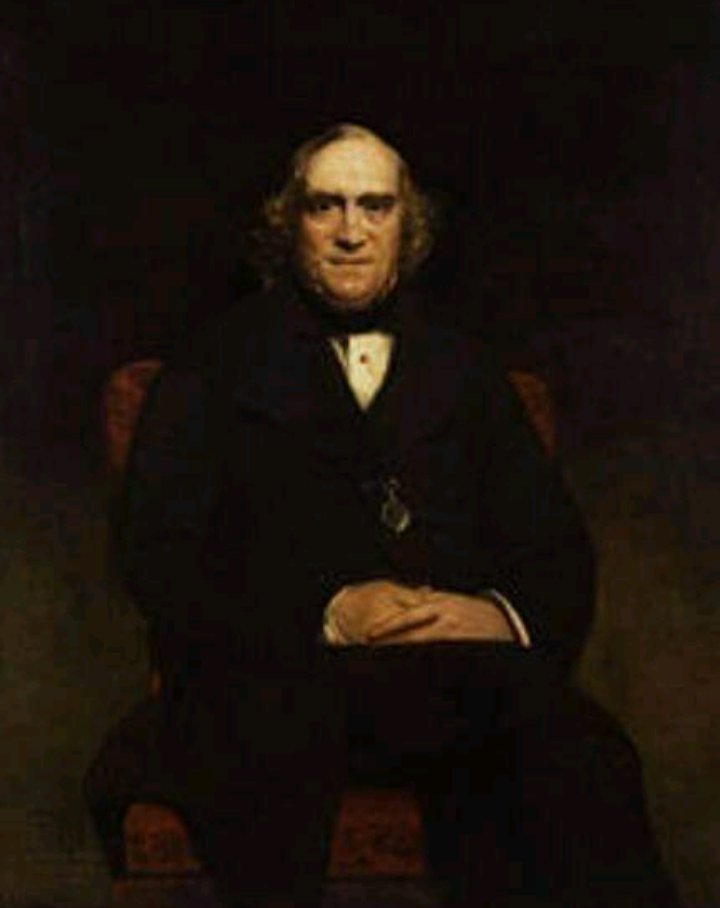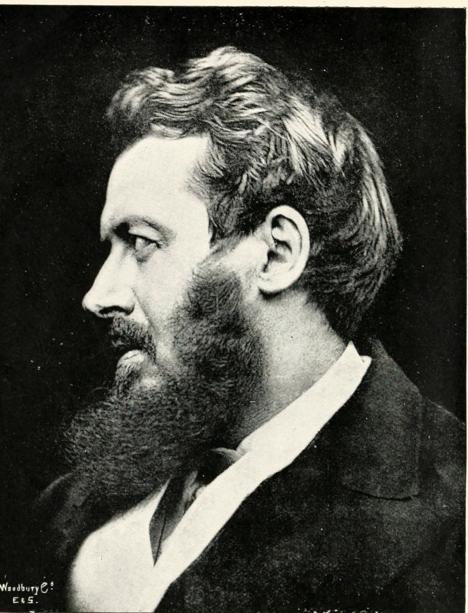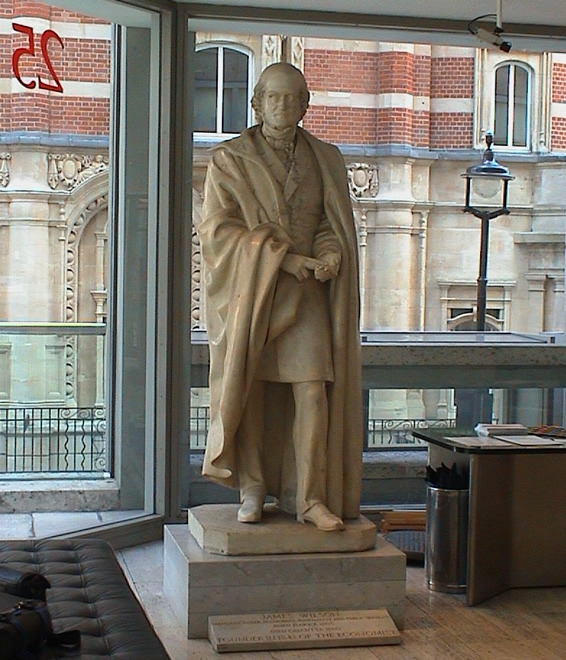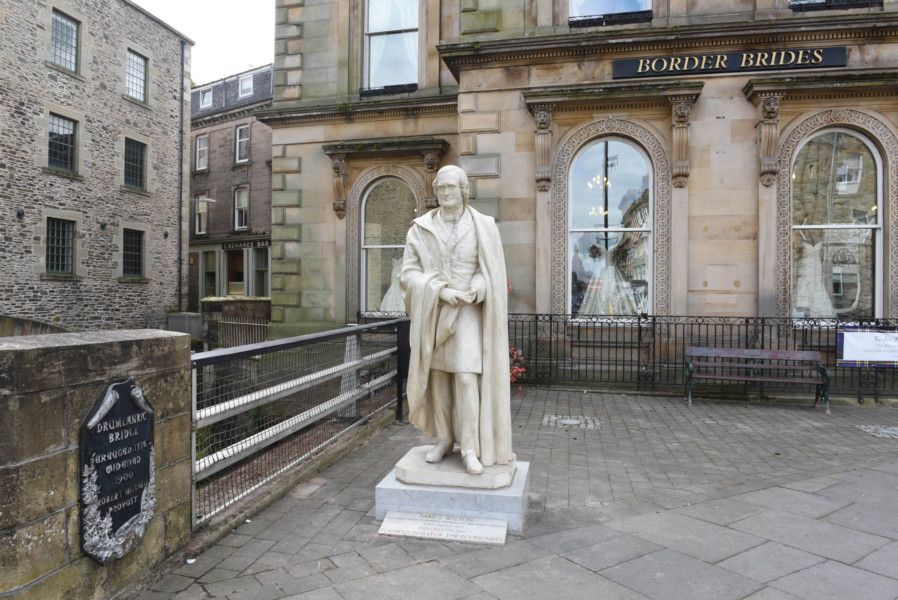
This post is a longer version of my article on James Wilson, the first Finance Member of the Viceroy’s Executive Council, which was published in Business Standard dated 21 January 2021. Please see the link here. Wilson was also the Founder of The Economist, and the Standard Chartered Bank. He presented the first Indian budget in 1860, and introduced income tax in the country. He also laid the foundations for introducing government paper currency in India the Indian Police, and the Office of the Comptroller and Auditor General, among other things.
In May 2019, a 12-foot high statue was reinstalled outside the Heritage Hub in Hawick, a small Scottish town bordering , with a declining population below 14,000. The statue was sculpted in 1863 by Sir John Steell, Queen Victoria’s official sculptor in Scotland, from a single block of carrara marble. The person so restored to a rightful honour is Rt. Hon. James Wilson, the first Finance Member of the Viceroy’s Executive Council in India, who presented the country’s first budget. That was only one of his many enduring accomplishments.
Early life
Born into a Quaker family on 3 June 1805, fourth in a family of 15 children, the young James wanted to study law. As the Quaker tradition frowned upon the legal profession, he tried a few other professions before becoming an apprentice to a local milliner manufacturing hats. He was a voracious reader spending his nights reading, becoming self-taught in various subjects, including Economics.
James Wilson’s father, a woollen manufacturer from a family of sheep farmers, purchased the firm for James and one of his brothers. The business soon became too big for Hawick. The brothers moved to London, when James was 19, setting up Wilson, Irwin, and Wilson, which did well but was dissolved in 1831. Despite losing substantial money trading in indigo, his first India connection, Wilson continued in business. But, he leveraged his practical wisdom to venture into public affairs.
Publisher
In 1839, he published his first pamphlet, Influences of the Corn-Laws, crusading for free trade. He would follow this with Fluctuations of Currency, Commerce, and Manufactures in 1840, and The Revenue; or, What should the Chancellor do, in 1841. In September 1843, he established The Economist as a broadsheet newspaper, to campaign for the abolition of the Corn Laws. In 1844, he retired from business, and invested most of his wealth and time in expanding The Economist. He himself wrote most of its lead articles. It became as influential then as it is today, nearly two centuries later.
Political life
Considering the benefit of active political life on Economist, James Wilson chose to enter Parliament. A chance conversation with Lord Radnor, an early benefactor of The Economist, helped him choose Westbury. Contesting as a Liberal Party candidate, he entered the House of Commons in 1847 by a margin of 21 votes. Mr Wilson made a mark soon after joining the House of Commons, his first speech having been on the commercial depression of the time. Within six months of entering the Parliament, Lord John Russell, then Prime Minister, offered Wilson the post of one of the Secretaries of the Board of Control, responsible for overseeing the East India Company. Wilson was initially reluctant as he felt he did not have the knowledge for it. But Lord Russell persuaded him to accept the position saying that it was his duty to serve the cause of the nation when called upon to.
While serving on the Board, he would pick up the special knowledge, but for which he would not have been, as he were to acknowledge later, able to undertake the regulation of Indian finance. He would also play a role in introduction of Railways in India which was being opposed on many grounds, such as “the effect upon the native mind,” “the impossibility of
inducing the Hindoos to travel in that manner,” etc. He continued in that position till the resignation of the Russell Cabinet in February 1852. Wilson would be re-elected in July that year from Westbury, this time by a still narrower margin of six votes.
Foray into banking
Wilson’s stint with the Board of Control made him realize the eroding power of the East India Company. Taking advantage of this and the discovery of gold in Australia, with a view to having a control over banking in the Far East, Wilson mooted the idea of a bank. It was to be named the Chartered Bank of India, Australia and China. The Prospectus was published in The Economist. In 1969, this bank would merge with the Standard Bank, based in South Africa, to become Standard Chartered, now one of the five largest in the UK and the largest foreign bank in India.
Financial Secretary to the Treasury
Wilson’s position on the Board of the Chartered Bank was shortlived. He would resign after the Aberdeen government offered him in January 1853 the position of Financial Secretary to the Treasury. He would continue in that position till the dissolution of the Lord Palmerston administration in 1858. Wilson’s reputation as a financial administrator was established during this tenure. Apart from his informal education in Economics, his success in business, remarkable memory, influential pamphlets and other writings, ability to make himself understood even in complex issues, balanced judgement, and quick decision making formed the basis of this reputation.
Other positions
After Lord Palmerston became Prime Minister again in June 1859, Wilson accepted the position of vice-president of Board of Trade, which he had rejected earlier. He was also made the paymaster general, and a privy councillor. But these proved to be short stints. Wilson was identified as the best person to put order into the chaos that was Indian finance after the “Sepoy Mutiny” of 1857, and the beginning of the British Raj in 1858.
Wilson goes to India

Wilson was reluctant at first to accept the position as the first Finance Member of the Viceroy’s Executive Council. He was expecting a Cabinet position, and was financially well off to want the attractive salary that was on offer. There were also concerns about the vagaries of the newspaper industry that could affect The Economist. He accepted only on public interest, because of his keen interest in Indian finance, and a sense of duty. He would put The Economist jointly under the charge of Walter Bagehot, who had married his first daughter, Eliza Bagehot would soon be the sole in charge and make a mark for himself. His writings, including the one on The English Constitution, and another one on central banking, Lombard Street: A Description of the Money Market (1873), would be enduring classics.
After taking leave of his constituents in his new constituency of Davenport, and his fellowmen in Hawick, Wilson left the shores of England on 20 October 1859. He was accompanied by his wife, three of his six daughters, and Mr Stirling Halsey of the ICS, another son-in-law who would be his private secretary.
Five contributions
Wilson set to work soon after reaching Calcutta in December 1859. He travelled to Lahore and back, met revenue officials, and decided “that it was a fine country to tax.” His idea of putting order into chaos involved five points: First, taxing hitherto exempt trading classes who benefited from government civil works. Second, establish a government paper currency. For this, he laid the groundwork, including the concepts of currency circles. Third, “reform and remodel our financial system by a plan of annual budgets and estimates, with a Pay Department to check issues, and keep them within the authorised limits,—and an effective audit.” Fourth, “a great police system of semi-military organisation… of purely civil application which …. will be cheaper by half a million than our present and expensive system…” The fifth was public works and roads. Wilson soon claimed great progress in the first four.
The first Indian Budget
Wilson presented his budget on 18 February 1860, India’s first. He rationalised various duties and announced an income tax, licence tax and tobacco duty. Bagehot wrote in The Economist that the budget, though involving high taxes, was well received as it was announced for five years. This ended uncertainty in taxation. Unexpected congratulations poured in and Wilson called himself “the most fortunate of tax-gatherers.” But, Sir Charles Trevelyan, Governor of Madras, recorded a Minute against the heavy taxation. He feared a fresh rebellion, and made the Minute public. Trevelyan was recalled for insubordination. But, the damage was done. Lord Canning, the Governor General, forced Wilson to drop the licence tax and tobacco duty.
A disappointed Wilson wrote that “Firmness and justice are the only policy for India: no vacillation, or you are gone. They like to be governed; and respect an iron hand, if it be but equal and just. I have, I think, more confidence than ever that the taxes will be established and collected, and without disturbance.”
Wilson considered the Indian Exchequer as a huge machine, compared to which “the English Treasury is nothing … for complexity, diversity, and remoteness of the points of action… a most unwieldy Empire…” His assessment of Indian administration could ring true even today: “Time, distance, and divided authority, with the sacrificing consequences of procrastination and shirking responsibility and the tendency to get rid of difficulties by compromise or delays are fatal elements in the character of the Government of India.”
Wilson would go on to have a Military Finance Commission and a Civil Finance Commission set up. As he would write to a friend, he was also “…reorganising the Finance, Pay, and Accountant General’s Department, in order to get all the advantage of the English system of estimates, Pay Office, and Audit…”
Last days
As the days wore on, the increasing heat which he was not used to, the Trevelyan affair and the public outcry that followed, disappointment at having to drop the license tax and tobacco duty, and the hard work, would take a toll on Wilson’s health. His wife and daughters would go to faraway Ootacamund in the Nilgiris. But, Wilson was aware that he was sent to India for his special qualifications and that nobody else could easily replace him or even be of assistance. The work on hand, especially organising new departments, required his presence, and energy.
Wilson plodded on quietly in Calcutta, shuttling between his residences in the city and at Barrackpore. With the onset of monsoon, dysentery set in. On 2 August, Wilson became bedridden, shifting to his doctor’s home. When his health deteriorated further, he called for Lord Canning, who saw him on the 9th, and recorded that he saw death in Wilson’s face. Wilson used the meeting to commend certain officers who had worked with him, and to outline the changes and other work that he had planned. He would also write one last letter to his wife, and separately to Bagehot and each one of his daughters.
On the 11th, he was sinking rapidly, and passed away at half-past six in the evening. He was buried in the Lower Circular Road Crematorium, Mullick Bazaar, Calcutta. Though he was in India only for eight months, his funeral procession attended by the Governor General downwards, would be two miles long, the largest Calcutta had seen. As Canning would write to London, “… this eminent public servant sacrificed his life in the discharge of his duty.”
Legacy
In India, Wilson introduced a rational system of public accounts that covered three important aspects, that of estimating future expenditure, system of budget, pay offices, and audit. He will also be remembered for introducing the government paper currency for which he presented his detailed plan in the Legislative Council on 3 March 1860. Apart from contributions to Indian finance, The Economist magazine, and Standard Chartered Bank are lasting legacies of Wilson. Then there is the Indian Railways, and the Indian Police. The bank is perhaps insignificant as compared to the other inasmuch as his involvement was only for a short period, and do not even find a mention in the memoirs of Wilson by either Bagehot or Emilie, his daughter.
As Sir Richard Temple would write later, “Wilson probably learnt more of the country in a very short time than any person who ever landed on its shores and his general information extended daily.” Walter Bagehot wrote in his memoirs of Wilson that he was a man with the gift of “efficient argument” that made him a “belief-producer.” Wilson combined his elephantine memory with economic wisdom and practical experience, and had the “power of conviction and uncanny insight about the proper time for change. His astuteness extended not only to events and men, but also to money.” As Bagehot would add, “He united high financial reputation, considerable knowledge of India acquired at the Board of Control, tried habits of business, long experience at the English Treasury, to the sagacious readiness in dealing with new situations which self-made men commonly have, but which is commonly wanting in others.”
Memorial
Stature in Calcutta
The mercantile community of Calcutta had a full-length statue of Wilson installed at the Dalhousie Institute in 1865. He shared space with former Governor Generals and Viceroys. Sir Evan Cotton in his 1907 book on Calcutta observed that all the others were moved to the Indian Museum pending transfer to the Victoria Memorial. He wondered why “James Wilson has not been permitted to follow them.”
The clue lies in Lord Curzon’s special address to the Asiatic Society on 26 February 1901, soon after the passing away of Queen Victoria. Delivered at the Dalhousie Institute itself, Curzon outlined the objectives of a suitable memorial for Queen Victoria to be built in Calcutta. While one or more galleries will be devoted to full-length sculptures, “Cases will arise in the future in which a desire to commemorate some eminent person may not justify, either in the scope of the services rendered or in the extent of the money subscribed, the crowning honour of a statue on the maidan. The busts of such persons will appropriately be placed in the sculpture gallery of the Victoria Hall.”
Curzon would go on to name the statues in the Dalhousie Institute like that of Lord Dalhousie himself and Chantrey’s Warren Hastings, which would eventually find a place in the Victoria Memorial. The statue of James Wilson which also was in the Grand Hall of the Dalhousie Institute where Curzon was speaking might have writhed at his omission. James Wilson found a place in a list of lesser worthies who would have “portraits, or busts, or mementoes.” All of Curzon’s worthies would move to the Indian Museum pending their final transfer to the Victoria Memorial Hall.

The statue moves
Wilson’s statue remained in the grand hall, in stately isolation, for over five decades. With the objectives of the Dalhousie Institute subsumed under the Victoria Memorial, it diversified into other mundane social activities. The Dalhousie Institute building itself was pulled down in 1960 to make way for the Telephone House. Someone had the good sense to have the Wilson statue transported back to London, where it was placed in the St. James Street Office of The Economist, which he had founded. When The Economist moved office, they gifted the statue to Hawick in 2017. It was installed at the Tower Knowe in August 2017. The location was found unsuitable after two right-hand fingers went missing in December that year. Now located outside the Heritage Hub, protected by CCTV, the statue looks towards High Street, where the subject was born. Hopefully, it will remain there forever.

Though Wilson’s mortal remains are in Calcutta, Hawick is proud and honoured to have the statue of their famous son. It now looks in the direction of High Street, where Wilson was born. Wilson himself would be happy to be back home, also content that his accomplishments are second to none, even Curzon, for their variety, farsightedness, and endurance. He could be humming to the old Scottish song:
“…the mist covered mountains of home!
There shall I visit the place of my birth.
They’ll give me a welcome the warmest on earth.
So loving and kind, full of music and mirth,
the sweet sounding language of home.”
Postscript
Two years after Wilson passed away, a young lad of 22 would land in Calcutta. He had stood first in the Indian Civil Service examination. Over the next nearly four decades, he would make significant contributions, in administration, statistics, history, and education, and author several books and reports, including a few novels. He was Sir William Wilson Hunter (1840-1900), the first two names coming from his maternal grandfather. His mother was one of the fourteen siblings of James Wilson.
© G. Sreekumar 2021.
For periodical updates on all my blog posts, subscribe for free at the link below:
https://gsreekumar.substack.com/
![]()